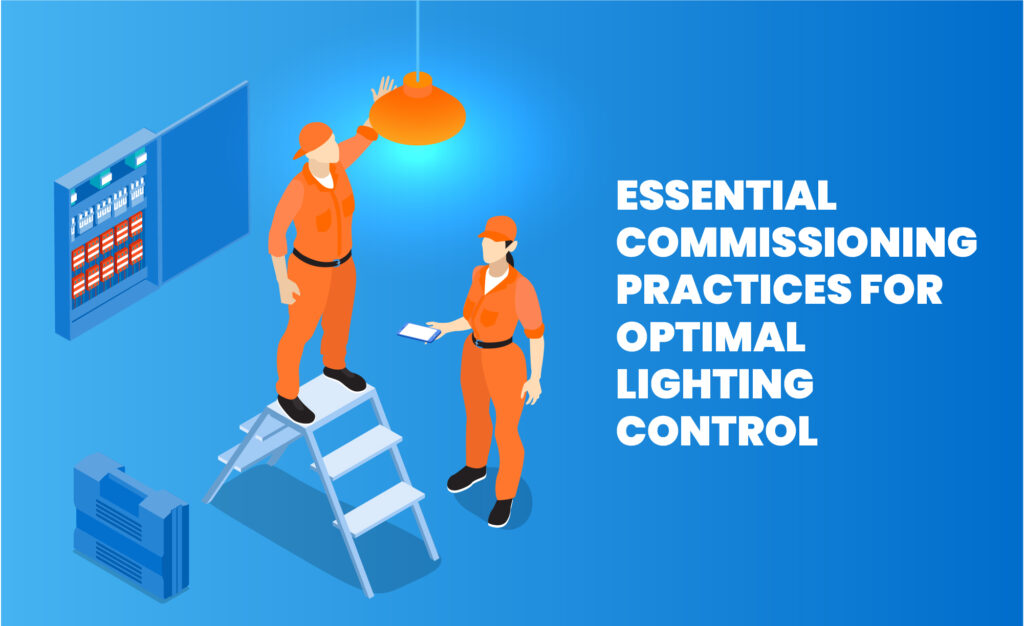Essential Commissioning Practices for Optimal Lighting Control

Did you know that lighting controls can be an excellent way to save energy? According to estimates, implementing lighting controls such as manual dimming and daylight harvesting can result in energy savings of 6-9% and a whopping 50-70%, respectively.
However, achieving these impressive savings requires more than just installing lighting controls. If the system isn’t properly commissioned, it may not function as intended or require extensive troubleshooting and adjustments. This can result in delays, added expenses, and frustration for everyone involved.
This blog post will explore some of the most effective lighting control commissioning practices and how they can benefit your projects. So, let’s not delay any further and dive right in!
Best Lighting Control Commissioning Practices
By implementing the best lighting control commissioning practices, you can reduce the likelihood of these issues arising. This includes things like thoroughly testing the system before installation and ensuring all components are properly configured.

Set up a building hierarchy: This helps to organize devices by location and simplify system management.
Give devices recognizable names: Assigning clear and descriptive names to devices makes identifying and managing them easier, especially in larger systems.
Develop a clear configuration plan: Having a clear plan for configuring devices, settings, and protocols reduces the likelihood of errors and can make troubleshooting easier.
Test the system: Thorough testing of the system before installation and after commissioning ensures that it operates as intended, meets performance requirements, and avoids future issues.
Implement security measures:
implementing security measures during lighting control commissioning is crucial to protect your lighting system. For example, upon powering on, the Lumos Controls devices go into commissioning mode for a brief period of 3 minutes. To ensure that only authorized personnel can access and commission them for their intended purposes during this period, a four-digit security code can be set up as a safeguard.

Lighting Control Commissioning: Lumos Controls Recommendations
To ensure effective control, reconfiguration, and troubleshooting in later stages, the best commissioning practices involve setting up a proper building hierarchy and assigning recognizable names to devices during commissioning, as Lumos Controls recommends.
This includes naming devices based on their location and function, such as “Amy’s office Light-1” or “Pantry Light-1”, and utilizing buildings, floors, and zones to take advantage of Lumos Controls features. This approach simplifies group and scene creation and ensures the right lights are included in configurations.
To illustrate this, imagine the Office layout image of the 1st floor of a building with three floors. On the 1st floor, this particular office can be considered a zone. Let us assume each room in this office has four lights (and four controllers).

While commissioning devices in this office to the zone, make sure to give them recognizable names – for example, a) The four devices in John’s office could be called JOL-1, JOL-2, JOL-3, and JOL-4 b) The four devices in Tony’s office could be called TOL-1, TOL-2, TOL-3, and TOL-4. This will ensure that it is easy to identify and add the right lights to the configurations when creating groups or scenes.
The Benefits of Lumos Controls Lighting Control Commissioning
Lumos Controls Lighting Control Commissioning offers a range of benefits that can make the commissioning process easier and more efficient.

One of the most significant advantages of Lumos Controls is that it provides a single app for commissioning, configuring, and controlling lighting control systems. This streamlines the process and makes it more convenient for electrical contractors to manage their projects.
Another key benefit of Lumos Controls is the ability to perform bulk commissioning. This means that multiple devices can be commissioned in one click, saving time and effort in larger projects. Lumos Controls enables you to configure pre-commissioning settings in advance, which further reduces the complexity and time required for the commissioning process. With pre-commissioning strategies, you only need to perform repetitive configuration tasks once, such as setting up high-end trim and low-end trim, saving you from doing it manually each time.
Final Word
Lumos Controls Lighting Control Commissioning offers a range of benefits that can make the commissioning process faster, easier, and more efficient for electrical contractors. By streamlining the process and providing advanced features like bulk commissioning and pre-configured settings, Lumos Controls can help contractors save time and money while delivering high-quality lighting control systems that meet the needs of building owners and occupants.
Looking to explore more about Lumos Controls Lighting Control Commissioning? Contact our team